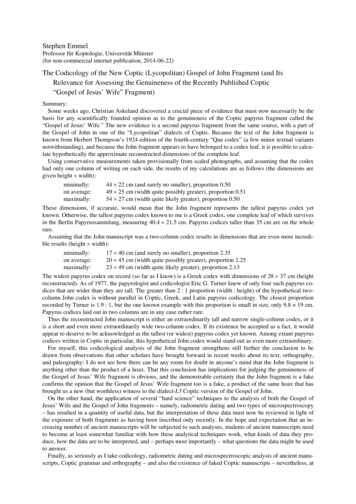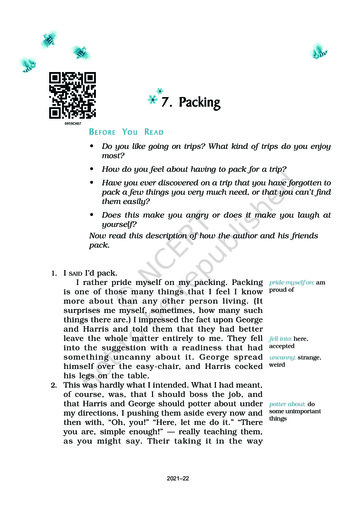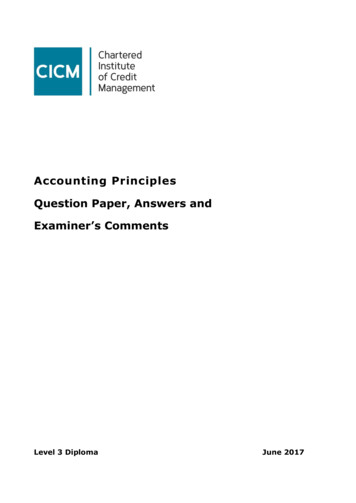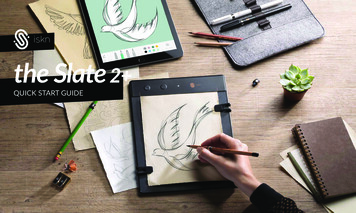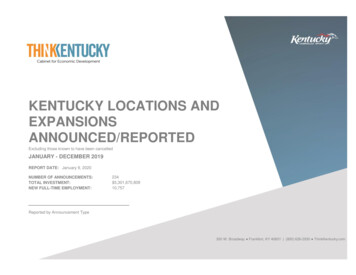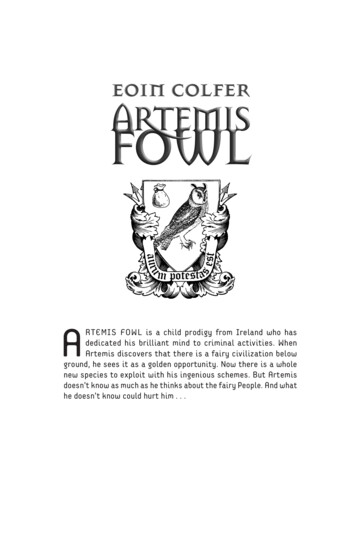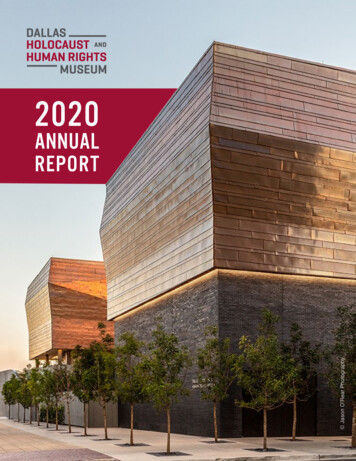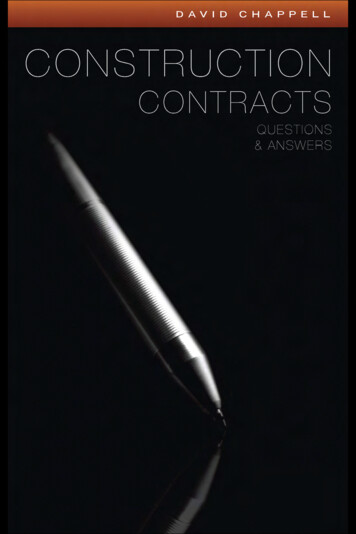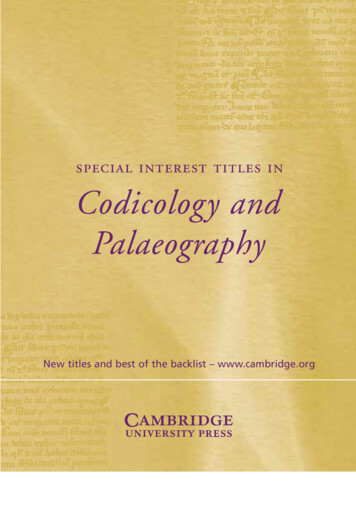
Transcription
Codicology andPalaeographyNew titles and best of the backlist – www.cambridge.org
This leaflet contains new andrecent titles specifically related tothe fields of Palaeography,Codicology and related titles tothe study of the manuscript andits history. Alongside new titles inthese subjects we also list the bestof our backlist, and don’t forgetyou can find out about these titlesand more by visiting our websitewww.cambridge.orgOr for any further information pleasecontact Emma Baxter, marketingcontroller, ebaxter@cambridge.org CAMBRIDGE STUDIES IN PALAEOGRAPHY AND CODICOLOGYCAMBRIDGE STUDIES IN MEDIEVAL LIFE AND THOUGHTCAMBRIDGE STUDIES IN MEDIEVAL LITERATURECAMBRIDGE TRANSLATIONS OF MEDIEVAL PHILOSOPHICAL TEXTSCAMBRIDGE STUDIES IN ANGLO-SAXON ENGLAND2MORE INFORMATION AVAILABLE FROM OUR WEBSITEwww.cambridge.org
ambridge Studies in Palaeographyand Codicology : Newnham College, University of Cambridge Trinity College, University of CambridgeThis series has been established to further the study of manuscriptsfrom the Middle Ages to the Renaissance. It includes books devotedto particular types of manuscripts, their production and circulation,to individual codices of outstanding importance and to regions,periods and scripts of especial interest to scholars. The series will beof interest not only to scholars and students of medieval literatureand history, but also to theologians, art historians and othersworking with manuscript sources. he Palaeography of GothicManuscript Books rom the Twelfth to the Early Sixteenth Century Vrije Universiteit Brussel and Universite Libre de BruxellsThis book is the first to present a detailed survey of all book scriptsin use in western and central Europe from c. 1100 to c. 1530 (withthe exception of Humanistic script). This period has been poorlyserved in almost all other palaeographical handbooks. By adoptinga largely new classification of scripts based on objective criteria,which incorporates many of the terms currently in use, this bookaims to end the confusion which has hitherto obscured the studyof late-medieval handwriting. It is based upon an examination of avery large number of dated specimens, and is thus the first surveyto take full advantage of the incomparable palaeographical resourceprovided by the Catalogues of Dated Manuscripts. The text isillustrated throughout with 600 drawings of letters and symbols.There are 160 actual-size reproductions providing datable specimensof all the scripts discussed, accompanied by partial transcriptionsand palaeographical commentary.CAMBRIDGE STUDIES IN PALAEOGRAPHY AND CODICOLOGYAugust 2003247 x 174 mm 300pp1 line diagram160 half tones520 figures0 521 803152Hardback c. 75.003
‘A distinctive mark of Davis'svaluable contribution to thishandsome Cambridge Series.’ he Gottschalk AntiphonaryMedium Aevum usic and Liturgy in Twelfth-Century Lambach This book reconstructs and studies the music, liturgy, and illustrationsof a twelfth-century manuscript from the Austrian monastery inLambach. The manuscript was taken apart in the fifteenth centuryand subsequently sold to various collectors in the twentieth century.The pages are here brought together (albeit photographically) forthe first time since the original manuscript was dismantled fivecenturies ago. The book includes a black-and-white facsimile of therecovered portion of the manuscript, and charts and tables are usedto demonstrate how it compares with other twelfth-century liturgicalmanuscripts.2000 247 x 174 mm332pp 80 half tones4 table 17 figures0 521 59249 6Hardback 60.00 he Scriptorium and‘A newparadigm forthe developmentof script in theMiddle Ages a splendidbook.’ScriptoriumLibrary at Monte Cassino,1058– 1105 Duke University, North Carolina1999 276 x 219 mm448pp 339 half tones9 colour plates0 521 58395 0Hardback 140.004In all the history of hand-written books, oneof the most distinctive and handsome scriptsis that of the abbey of Monte Cassino in itsclassic form. This study shows how thescribes of the late eleventh century developedtheir geometrical style of handwriting andthoroughly investigates and illustrates its rulesand conventions. The book provides abackground for the world-famous copies ofworks – many of them uniquely preserved atMonte Cassino – of classical authors, churchFathers, and medieval writers.
ision and Meaning inNinth-Century Byzantium mage as Exegesis in the Homilies ofGregory of Nazianus University of BirminghamThis book centres on the copy of the Homiliesof Gregory of Nazianzus produced inConstantinople around 880 for the emperorBasil I as a gift from the patriarch Photios.The manuscript includes forty-six full pageminiatures, most of which do not directlyillustrate the text they accompany, but insteadprovide a visual commentary. Vision andMeaning in Ninth-Century Byzantium dealswith how such communication worked, andexamines the types of messages that thepictures could convey to contemporaries.1999 247 x 174 mm568pp 177 half tones59 figures0 521 62153 4Hardback 80.00‘A monumentof excellentscholarship formany years tocome.’Early MedievalEurope‘A learnedand thoughtprovokingbook.’Cyril Mango,Byzantine andModern GreekStudies iles of Rome’s ‘De RegiminePrincipum’ eading and Writing Politics at Court and University,c. – . Georgia Southern UniversityFrom the time of its composition (c.1280) for Philip the Fair ofFrance until the early sixteenth century, Giles of Rome’s mirror ofprinces, the De regimine principum, was read by both lay andclerical readers in the original Latin and in several vernaculartranslations, and served as model or source for several works ofprincely advice. This study uses an interdisciplinary approachtowards the surviving manuscript copies, as well as documentaryand literary evidence, to show how people of the later Middle Agesread Giles’s text and appropriated it for their own particular purposes.CAMBRIDGE STUDIES IN PALAEOGRAPHY AND CODICOLOGY1999 247 x 174 mm222pp 17 half tones8 tables0 521 57053 0Hardback 50.005
he Harley Psalter University of Cambridge1996 247 x 174 mm249pp 6 line diagrams77 half tonesThis is a fascinating study of the making ofthe Harley Psalter, an illustrated manuscriptwhich was produced at Christ Church,Canterbury over a period of about 100 years,from c. 1020 to c. 1130. William Noel analyseshow the artists and scribes worked with eachother and with their manuscript exemplars inmaking their illustrated text. This is a crucialwork for understanding the development ofart, script and book making during what hasbeen termed the ‘golden age’ of Anglo-Saxonart.0 521 46495 1Hardback 50.00 : he Bobbio MissalThe Early MedievalBible Its Production,Decoration and Useomen as ScribesEdited byRichard Gamesonook Production and Monastic Reform in Twelfth CenturyBavaria Manuscripts andLibraries in the Ageof CharlemagneBernhard BischoffTranslated and Edited byMichael GormanCultural Interplay inthe Eighth CenturyThe Trier Gospels andthe Making of aScriptorium atEchternach he Service Books of Santa Maria del Fiore athedral and Civic Ritual in Late Mediebal and RenaissanceFlorence eading in Medieval St Gall Nancy Netzer6CAMBRIDGE STUDIES IN PALAEOGRAPHY AND CODICOLOGY
1990 228 x 152 mm303ppatin Palaeography0 521 36726 3Paperback 19.95ntiquity and the Middle Ages This work, by the greatest living authority on medieval palaeography,offers the most comprehensive and up-to-date account in anylanguage of the history of Latin script. It also contains a detailedaccount of the role of the book in cultural history from antiquityto the Renaissance, which outlines the history of book illumination.Designed as a textbook, it contains a full and updated bibliography.Because the volume sets the development of Latin script in itscultural context, it also provides an unrivalled introduction to thenature of medieval Latin culture. It will be used extensively in theteaching of latin palaeography, and is unlikely to be superseded. List of abbreviations; Preface; Introduction; Part I. Codicology:1. Writing materials and writing tools; 2. The external characteristicsof the written heritage; 3. Writing and copying; Part II. The Historyof Latin Script: 4. Latin script in antiquity; 5. Latin handwriting inthe Middle Ages; 6. Supplement; Part III. The Manuscript in CulturalHistory: 7. Roman and Christian antiquity; Plates; Bibliography;Index of names and subjects.‘Latinpalaeographyhas receivedits vademecum fromits foremostrepresentative.’Eranos7
haucer: The wife ofBath’s Prologue onCD-Rom 245 x 168 mmDe Montfort University, Leicester0 521 46593 1CD-Rom 150.00The Wife of Bath’s Prologue on CD-ROMinaugurates a revolutionary new kind of‘book’: an electronic textual edition of amajor work of literature containing all theoriginal sources for the work, both transcribedand in image form, with sophisticatedsearch software and scholarly apparatus – asignificant innovation in textual bibliography.diting Piers Plowman he Evolution of the Text University of OxfordThe fifty-plus manuscripts of Piers Plowman have always poseda puzzle to scholars. This book is an account of the editions ofthe poem which have appeared since 1550, examining thecircumstances in which the editions were produced, the lives andintellectual motivations of the editors, and the relationship betweenone edition and the next.Cambridge Studies inMedieval Literature, 281996 228 x 152 mm468pp0 521 34250 3Hardback 65.008
ewriting Old Englishin the Twelfth Century University of Leeds . University of LeciesterThe first substantial publication in the growingfield of studies of texts in Old English in thetwelfth (and early thirteenth) century. Usefulto historians, linguists, English, Anglo-Normanand Latin literature scholars and manuscriptspecialists, it covers a wide variety of significantissues including production, audience, contentsand uses.Cambridge Studies inAnglo-Saxon England, 302000 228 x 152mm224pp 11 half tones0 521 62372 3Hardback 45.00 rint Manuscripts and the Searchfor Order 1450 –1830 c This book re-examines fundamental aspects of what has beenwidely termed the printing revolution of the early modern period.David McKitterick argues that many of the changes associatedwith printing were only gradually absorbed over almost 400 years,a much longer period than usually suggested.July 2003 247 x 174 mm 360pp 44 half-tones0 521 82690 X Hardback c. 45.009
raphic Design, Print Culture and the Eighteenth Century Novel University of Texas, AustinMay 2003247 x 174 mm 320pp110 half tones0 521 81908 3Hardback c. 45.00The uniformity of the eighteenth-century novel in today’spaperbacks and critical editions no longer conveys the early novel’svisual exuberance. Janine Barchas explains how during the genre’sformation in the first half of the eighteenth century, the novel’smaterial embodiment as printed book rivalled its narrative contentin diversity and creativity. Innovations in layout, ornamentation, andeven punctuation found in, for example, the novels of Richardson,an author who printed his own books, help shape a tradition ofearly visual ingenuity. From the beginning of the novel’s emergencein Britain, prose writers including Daniel Defoe, Jonathan Swift,and Henry and Sarah Fielding experimented with the novel’sappearance. Lavishly illustrated with more than 100 graphicfeatures found in eighteenth-century editions, this important studyaims to recover the visual context in which the eighteenth-centurynovel was produced and read. Acknowledgments; List of illustrations; 1. Expanding the literarytext: a textual studies approach; 2. The frontispiece: counterfeitauthority and the author portrait; 3. The title page: advertisement,identity, and deceit; 4. Clarissa’s musical score: a novel’s politicsengraved on copper plate; 5. The space of time: graphic design andtemporal distortion; 6. Sarah Fielding’s David Simple: a case study inthe interpretive significance of punctuation; 7. The list and index: aculture of collecting imprints upon the novel.10
iteracy in Lombard Italy,c. 568 – 774 Harvard University, MassachusettsItaly had long experienced literacy underRoman rule, but what happened to literacyin Italy under the rule of a barbarian people?This book examines the evidence for the useof literacy in Lombard Italy c. 568–774, aperiod usually considered as the darkest ofthe Dark Ages in Italy due to the poor survivalof written evidence and the reputation of theLombards as the fiercest of barbarian hordesever to invade Italy. A careful examination ofthe evidence, however, reveals quite a differentstory. This study considers the different typesof evidence in turn and offers a re-examinationof the nature of Lombard settlement in Italyand the question of their cultural identity. Farfrom constituting a Dark Age in the history ofliteracy, Lombard Italy possessed a relativelysophisticated written culture prior to theso-called Carolingian Renaissance of the ninthcentury.Cambridge Studiesin Medieval Life andThought: Fourth Series 53March 2003228 x 152 mm414pp 12 half tones2 maps0 521 81905 9Hardback c. 50.00 Introduction; 1. Italy and literacy before theLombards; 2. The early Lombards and theirsettlement in Italy; 3. Language and literacy(i) Lombard language (ii) Latin; 4. Law andgovernment; 5. Charters; 6. Inscriptions;7. Manuscripts; Conclusion.11
he Cambridge Genizah Collections heir Contents and Significance
he Service Books of Santa Maria del Fiore athedral and Civic Ritual in Late Mediebal and Renaissance Florence eading in Medieval St Gall CAMBRIDGE STUDIES IN PALAEOGRAPHY AND CODICOLOGY 1996 247 x 174 mm 249pp 6 line diagrams 77 half tones 0 521 46495 1 Hardback 50.00 .
